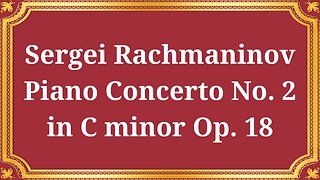Premium Only Content

Maurice Ravel Rapsodie Espagnole
Maurice Ravel's Rapsodie Espagnole is a captivating and dynamic orchestral piece that showcases the composer's signature style of impressionism. Written in 1907-08, the work consists of four movements, each inspired by Spanish folk music and culture.
Maurice Ravel began composing Rapsodie Espagnole in 1907, during a period when he was deeply influenced by Spanish music and culture. He had recently returned from a trip to Spain, where he attended numerous flamenco performances and was fascinated by the intricate rhythms and melodies of Spanish folk music.
The piece was premiered in Paris in 1908, conducted by Paul Paray. Initially, the work was received with mixed reviews, with some critics dismissing it as "an imperfect attempt to capture the essence of Spanish music." However, Rapsodie Espagnole soon became one of Ravel's most popular works, and today it is regarded as a masterpiece of orchestral music.
Rapsodie Espagnole consists of four movements:
Prelude a la nuit (Prelude to the Night) - The first movement features a dreamy and romantic melody played by the woodwinds and strings. The music gradually builds in intensity, with the addition of brass and percussion, before fading away into a quiet and mysterious conclusion.
Malaguena - The second movement is a lively and rhythmic dance inspired by the traditional Malagueña style of Andalusia. The music features a prominent castanet rhythm, which is played by the percussion section, and a catchy melody played by the clarinet and trumpet.
Habanera - The third movement is a slow and sultry dance that is characterized by a distinctive rhythm and melody. The music is marked by the use of glissandos in the strings and a solo violin that plays a mournful melody.
Feria - The final movement is a festive and energetic dance that evokes the atmosphere of a Spanish fair. The music is characterized by a fast and complex rhythm, with multiple themes that are woven together in a grand finale.
Rapsodie Espagnole is known for its distinctive harmonies, colorful orchestration, and inventive use of rhythm. Ravel's use of Spanish folk melodies and rhythms was groundbreaking at the time, and it helped to establish him as one of the leading composers of the early 20th century.
The piece is also notable for its use of orchestral color, with each movement featuring a unique combination of instruments and timbres. For example, the Habanera features a solo violin that is accompanied by muted trumpets and pizzicato strings, creating a distinctive and evocative sound.
In conclusion, Maurice Ravel's Rapsodie Espagnole is a masterpiece of orchestral music that showcases the composer's unique style and innovative use of Spanish folk music. With its captivating melodies, complex rhythms, and colorful orchestration, Rapsodie Espagnole continues to captivate audiences over a century after its composition.
Maurice Ravel Rapsodie Espagnole
1 Ravel Rapsodie Espanole 00:00
2 Ravel Rapsodie Espanole 02:02
3 Ravel Rapsodie Espanole 06:09
4 Ravel Rapsodie Espanole 08:36
#classical_music #Maurice_Ravel #Rapsodie_Espagnole #classical_music
-
 34:38
34:38
Classical music_Music Inspiration
18 days agoSergei Rachmaninov Piano Concerto No. 2 in C minor Op. 18
38 -
 LIVE
LIVE
Wendy Bell Radio
6 hours agoAmerica Is Done Being The World's B*tch
9,691 watching -
 LIVE
LIVE
2 MIKES LIVE
1 hour agoTHE MIKE SCHWARTZ SHOW with DR. MICHAEL J SCHWARTZ 04-09-2025
347 watching -
 1:27:21
1:27:21
JULIE GREEN MINISTRIES
4 hours agoLIVE WITH JULIE
150K154 -
 1:27:41
1:27:41
Game On!
15 hours ago $10.44 earnedA Tradition Unlike Any Other with Paige Spiranac! Master 2025 Preview!
59.5K3 -
 18:28
18:28
World2Briggs
21 hours ago $8.02 earnedTop 10 Cities That Are Held Together with Duct Tape
45.5K25 -
 17:50
17:50
Degenerate Jay
14 hours ago $7.25 earnedGoodbye Val Kilmer - Batman, Forever
50.6K15 -
 18:16
18:16
IsaacButterfield
1 day ago $3.90 earnedThe Police Were Called!
39.4K8 -
 8:57
8:57
Hannah Barron
23 hours agoBass Fishing from a Paddleboard!
65.1K46 -
 8:34
8:34
The Rich Dad Channel
14 hours agoIf You're an Employee You're Running Out of Time, Watch This Before It’s Too Late
41.2K2